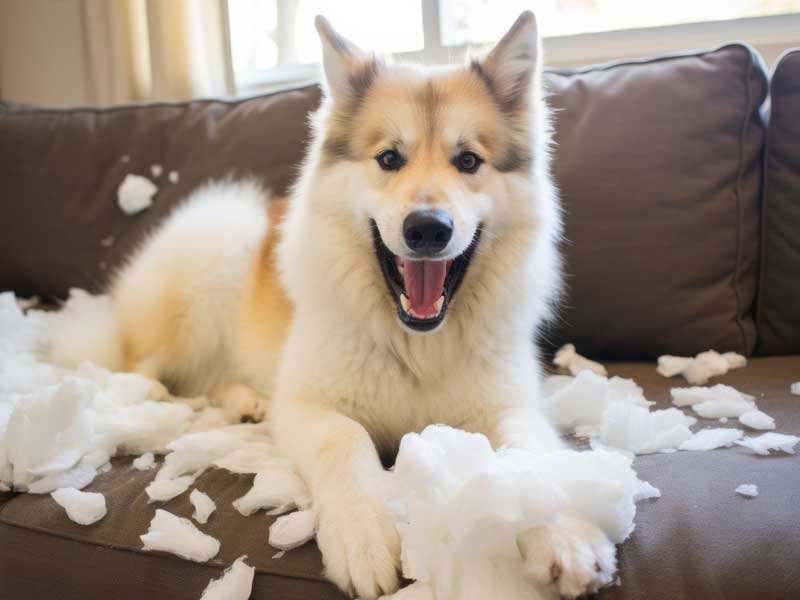Understanding Why Dogs Chew on Things When Left Alone
Why does your dog chew on things when left alone? This is a common question among dog owners, and it’s essential to understand the reasoning behind this behavior. By unraveling the mystery, you can implement strategies to prevent unwanted chewing and ensure your furry friend stays happy and healthy.

Understanding Canine Chewing Behavior
Chewing is a natural behavior for dogs, particularly when they are left alone. It’s essential to recognize that this action can stem from various factors, including anxiety, boredom, and even dental discomfort. By identifying the underlying cause, you can better manage your dog’s chewing habits.
The Natural Instinct to Chew
All dogs have a natural instinct to chew. This behavior is inherited from their wild ancestors, who chewed on bones and other materials to access the nutrients inside. Chewing also helps dogs keep their teeth clean and jaws strong. Understanding this instinct is the first step in addressing unwanted chewing.
Chewing as Exploration
Dogs experience the world primarily through their senses, particularly their mouths. Chewing allows them to explore their environment and learn about the textures and tastes of various objects. If your dog is curious, you might find them gnawing on different items in your home when left alone.
Reasons for Chewing When Alone
When you leave your dog alone, several triggers can instigate their chewing behavior. Let’s discuss some common causes to help you understand your furry friend better.
Separation Anxiety
One of the most frequent reasons for chewing when left alone is separation anxiety. Dogs are social animals and often struggle with being apart from their owners. They may chew on items as a way to cope with the stress of your absence. Signs of separation anxiety may include:
| Signs of Separation Anxiety | Description |
|---|---|
| Excessive barking or howling | Your dog may vocalize when you’re gone. |
| Destructive behavior | Chewing furniture or personal items, including shoes or clothing. |
| Pacing | Your dog may walk back and forth or seem restless. |
| Housebreaking accidents | Some dogs may revert to previous potty training habits. |
Understanding that your dog’s chewing could be linked to anxiety can be the first step toward finding a solution.
Boredom and Lack of Stimulation
Just like humans, dogs can get bored if they lack physical or mental stimulation. When left alone for extended periods, they may resort to chewing to entertain themselves. This behavior can often be seen in younger dogs, who possess high energy levels.
Teething
If you have a puppy, their chewing might be related to teething. Just like human babies, puppies go through a teething phase that can cause discomfort. Chewing can help alleviate the pain associated with emerging teeth. During this time, it’s important to provide appropriate toys that are specifically designed for teething puppies.
Attention-Seeking Behavior
Some dogs learn that chewing on objects draws attention, even if it’s negative attention. If you rush home to scold your dog for chewing, they may perceive this as a way to get your attention. If your dog enjoys your reaction, they might continue to chew while you’re away.
Unmet Exercise Needs
If your dog isn’t getting enough exercise, they may have excess energy to expend. Dogs typically require a certain amount of physical activity each day, and if these needs aren’t met, they may resort to chewing. Consider your dog’s breed, age, and activity level when determining appropriate exercise requirements.
Managing Chewing Behavior
Now that you have a better understanding of why dogs chew on objects when left alone, you might be curious about how to manage this behavior effectively. Here are some strategies to consider.
Creating a Comfortable Environment
Make your home a comfortable environment for your dog. This can include providing a cozy bed or crate, where they feel secure while you are away. The goal is to help alleviate anxiety by creating a safe space.
Providing Appropriate Chew Toys
Choosing the right chew toys can help redirect your dog’s chewing behavior. Invest in durable toys that are safe for your dog’s size and chewing strength. There are also interactive toys that keep your dog mentally stimulated and engaged, reducing the likelihood of unwanted chewing.

Establishing a Routine
Dogs thrive on routine, which provides them with a sense of security. Establish a daily schedule that includes regular feeding times, walks, and play sessions. When your dog knows what to expect, it can help reduce anxiety and excess energy that leads to chewing.
Gradual Desensitization
If your dog exhibits signs of separation anxiety, consider a gradual desensitization approach. Start by leaving them alone for short periods and gradually increasing the time as they become more comfortable with your absence. Reward them for calm behavior during this process to reinforce good habits.
Redirecting Behavior
If you catch your dog chewing on an inappropriate item, calmly redirect their attention to an appropriate chew toy. Praise and reward them when they choose the right toy instead. This helps them learn what is acceptable to chew on.
Seeking Professional Help
If you’ve tried various strategies and your dog’s chewing behavior isn’t improving, consider consulting a professional dog trainer or a veterinary behaviorist. They can provide tailored advice and techniques to address specific concerns.
Conclusion
Understanding why your dog chews on things when left alone can significantly contribute to better behavior management. Whether it’s separation anxiety, boredom, teething, or attention-seeking, identifying the reasons behind the behavior is essential in finding effective solutions. By creating a nurturing environment, providing appropriate toys, establishing routines, and promoting positive behavior, you can help your furry companion feel more secure and reduce their urge to chew on unwanted items.
Managing chewing behavior takes time and patience, but you can pave the way for a happy, healthy relationship with your dog. By addressing these needs, you’re not only preventing damage to your belongings but also enhancing your dog’s overall quality of life.






